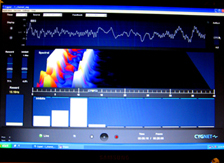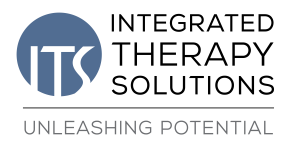Wouldn’t you love to see what your brain does so you could correct it? We have a way of showing you just that.
 Neurofeedback is brain exercise. We observe your brain in action from moment to moment by monitoring your brain waves. We show you your brain activity and we help you to change it by rewarding shifts toward a more appropriate and stable brain state. It is a gradual learning process.
Neurofeedback is brain exercise. We observe your brain in action from moment to moment by monitoring your brain waves. We show you your brain activity and we help you to change it by rewarding shifts toward a more appropriate and stable brain state. It is a gradual learning process.
Neurofeedback is also called EEG biofeedback. The electroencephalogram (EEG) is another name for the brain wave recordings and, in this context, biofeedback refers to the process by which you learn to change your brain waves and thereby gain better control over your brain states.
What Can Neurofeedback Help?
Neurofeedback is training in self-regulation. Good self-regulation is necessary for optimal brain function. Self-regulation training enhances the function of the central nervous system and thereby improves mental performance, emotional control and physiological stability.
With Neurofeedback we target bioelectrical functioning of brain which is actually a more important issue than the “chemical imbalance” that is often talked about. We are concerned with the brain’s internal regulatory networks, and we train the brain’s functional disregulation. Simply by detecting the brain going off track through the EEG, we can train the brain toward enhanced stability and improved functioning.
In other respects, Neurofeedback is somewhat like putting the brain on a stair stepper to exercise certain regulatory functions continuously. This is applicable to a wide variety of functional deficits.
Does Neurofeedback cure symptoms or conditions?
In the case of organic brain disorders, it is a matter of getting the brain to function better rather curing the condition. When it comes to problems of disregulation, we would say that there is not a disease to be cured, and self-regulation may very well be a complete remedy.
Who Can Benefit from Neurofeedback?
Individuals of any age can benefit from EEG training. Neurofeedback can help a variety of childhood problems including bedwetting, nightmares, attention deficits and other forms of disruptive and disturbing behaviors. Neurofeedback can assist adolescents who struggle with anxiety and depression or drug and alcohol use.
For adults, Neurofeedback can alleviate symptoms of physical and emotional problems such as migraines or PTSD Neurofeedback can help anyone maintain good brain function as they age. Peak performers also use EEG training to enhance their abilities in sports, business and the arts.
How is Neurofeedback Done?
Sensors are attached to the scalp with EEG paste which then pick up brain waves. It is painless and does not involve the application of any voltage or current to the brain. So it is entirely non-invasive.
A computer processes the brain waves and extracts certain information from them. We show you the ebb and flow of your brain waves, and the specific information we obtain form them, in the form of a video game.
We instruct you how to play the video game using only your brain waves. (Everyone can do it) The specific brain wave frequencies we reward and the sensor locations on the scalp are unique to each individual.
What happens if Neurofeedback Clients are Taking Medications?
With successful Neurofeedback training, medications targeting brain function may no longer be needed, or they may be needed at lower dosages, as the brain takes over the role of regulating itself. It is important for clients to communicate with prescribing physician regarding Neurofeedback and medications.
Who is helped by this:
| Neurofeedback | Who: | Children, Adolescent, Adults |
| AD/HD, Autistic Spectrum Disorder, Learning Disability, Depressive Disorder,Anxiety Disorder, Panic Disorder, Sleep Disorder, Headaches, Peak Performance | ||
| Comprehensive Career Program | Who: | Jr HS, HS, &College students and adults |
| College Major Selection for students. Six different tests will be given to measure one’s interests, abilities, work values, personality style, and study methods/attitudes. Career Change for an adult | ||
What is AD/HD (Attention Deficit/Hyperactivity Disorder)?
Attention-Deficit/Hyperactivity Disorder is one of the most common neurobehavioral disorders.
Some inattentive and hyperactive-impulsive symptoms that cause impairment usually presented before age 7 years.
Major symptoms of AD/HD include:
Attention Deficit
- Dose not seem to listen when spoken to
- Makes careless errors
- Avoids or dislikes tasks requiring sustained attention
- Short attention span
- Disorganized
- Loses things
- Procrastinates
- Easily distracted
- Forgetful in daily activity
- Difficulty completing tasks
- Gets bored easily
- Stares into space/daydreaming
- Low energy, sluggish or drowsy
- Apathetic or unmotivated
- Frequently switches from one activity to another
- Trouble concentrating
- Falls asleep doing work
- Failure to meet deadlines
- Underachiever
- Trouble following directions
- Excited in the beginning but doesn’t finish
- Difficulty learning/remembering
- Works best under deadlines/pressure
Hyperactivity
- Fidgets with hands and feet
- Squirms in seat
- Frequently leaves seat inappropriately
- Moves excessively
- Difficulty working quietly
- On the go
- Driven
- Talks excessively
- Can’t sustain eye contact
- Needs a lot of supervision
- Pays attention to everything
- Frequently “rocks”
- Excitability
- Lacks patience
- In trouble frequently
- Restless
Impulsivity
- Cannot see consequences of behavior
- Blurts out comments
- Difficulty waiting turn
- Frequently interrupts
- Butts into others conversation
- Engages in physically dangerous activity
- Acts before thinking
- Frequently takes risks
- Takes all dares
- Frustrated easily
